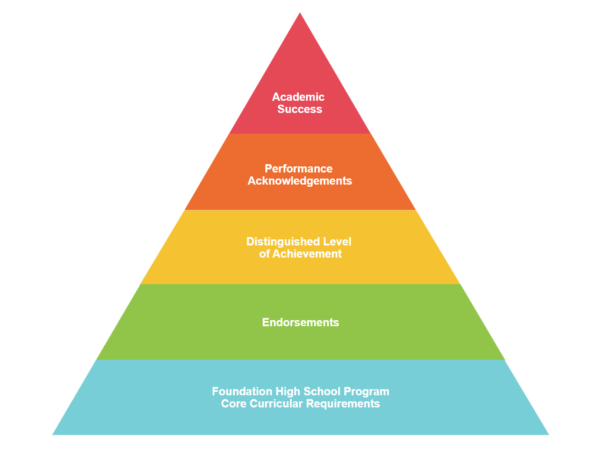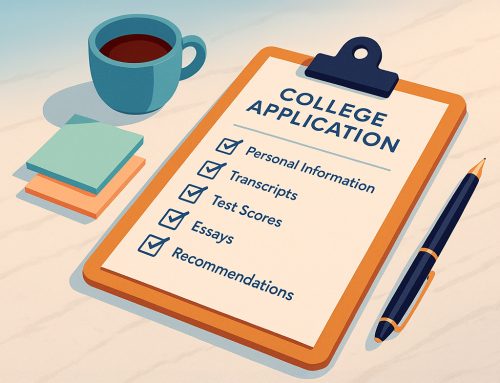Texas high school students have two main pathways to graduation:
- the Texas Foundation High School Program, and
- the Texas First Early High School Diploma Program.
Since the 2014-2015 school year, the Foundation High School Program (FHSP) has been the default route for graduation for all Texas public high school students. The FHSP replaced the previous three-track degree program, which allowed students to pick between a Minimum, Recommended, or Distinguished degree program. Recently, Texas introduced the Texas First Early High School Diploma Program, offering an alternate pathway for high-achieving students to graduate early. This article delves into both programs, highlighting their requirements, benefits, and key distinctions.
The Texas Foundation High School Program
The FHSP sets the baseline for graduation in Texas, providing a basic educational track for all students, with options to specialize through endorsements in areas of interest. The program consists of 22 credits in core subjects (English, Mathematics, Science, and Social Studies), physical education, languages other than English (including computer programming languages), and electives. Additionally, students can earn endorsements in five areas: STEM, Business and Industry, Public Services, Arts and Humanities, and Multidisciplinary Studies, requiring a total of 26 credits.
Put simply, the FHSP is analogous to college core requirements, and endorsements are therefore akin to college majors. The only difference is that it is not technically required to complete an endorsement in order to graduate from a Texas public high school; the closest comparison to college would be for an undergraduate student to graduate with a “liberal arts major,” which some colleges offer to those students who chose not to declare a predefined major.
Endorsements
The FHSP offers endorsements in five areas—STEM, Business and Industry, Public Service, Arts and Humanities, and Multidisciplinary Studies—similar to college majors, achieved by completing designated course sequences. These endorsements help students focus on their interests, guiding them toward potential career paths, with school counselors offering vital support in course selection and planning.
- STEM – The STEM endorsement is ideal for students interested in careers related to science, technology, engineering, or mathematics. Achieving this endorsement involves completing a series of courses in one or more of these areas, including computer science, CTE (Career and Technical Education) courses from the STEM cluster, mathematics, and science. This endorsement prepares students for a future in the rapidly growing STEM fields.
- Business and Industry – This endorsement caters to students aiming for careers in various sectors such as architecture, project management, finance, or information technology. It encompasses a wide range of courses, including CTE courses from relevant career clusters like Agriculture, Food, and Natural Resources; Architecture and Construction; and Information Technology, among others. Electives in areas like public speaking, debate, and technology applications are also part of this endorsement, offering a broad base for future business and industry professionals.
- Public Service – For students drawn to careers in public service sectors such as education, government, health science, or law enforcement, the Public Service endorsement is designed to align with their vocational goals. Completing a sequence of CTE courses from the Education and Training, Health Science, or Law, Public Safety, Corrections, and Security clusters, or participating in Junior Reserve Officer Training Corps (JROTC), can earn students this endorsement.
- Arts and Humanities – For those drawn to the arts, literature, languages, or social studies, the Arts and Humanities endorsement offers a path to explore these interests deeply. It includes studying four levels of the same foreign language or two levels each of two different languages, American Sign Language (ASL), social studies, or engaging in fine arts across various disciplines such as art, dance, music, and theater.
- Multidisciplinary Studies – The Multidisciplinary Studies endorsement is a versatile option suitable for students with broad interests or those uncertain about their career paths. It requires four advanced courses that either prepare a student for postsecondary education without remediation or involve a combination of courses from different endorsement areas not in a coherent sequence.
For every endorsement, the TEA requires that students complete one additional credit each in Math and Science (from 3 to 4), two additional elective credits (from 5 to 7), and the “sequence of courses” specific to that endorsement. The specific requirements for the sequences of courses required by the various endorsements are set by each individual school district. Furthermore, each high school within a school district can decide which of the five endorsements to offer, as long as they offer at least one. Students should consult their high school counselor to confirm their available options.
Table 1: Curricular Requirements for Endorsements. Source: TEA.
| Endorsement | Course Options |
|---|---|
| STEM |
To earn the STEM endorsement, students must also complete a sequence of courses in one of the following areas, or a combination of courses from no more than two areas:
|
| Business & Industry |
To earn the Business & Industry endorsement, students must also complete a sequence of courses in one of the following areas, or a combination of courses from no more than two areas:
|
| Public Services |
To earn the PUBLIC SERVICE endorsement, students must also complete a sequence of courses in one of the following areas:
|
| Arts & Humanities |
To earn the ARTS & HUMANITIES endorsement, students must also complete one of the following:
|
| Multidisciplinary Studies |
To earn the MULTIDISCIPLINARY STUDIES endorsement, students must also complete one of the following:
|
Selecting and Changing Endorsements
Students must choose an endorsement in their freshman year but can change it if their interests evolve. While initially selecting an endorsement is mandatory, students have the option, with parental or guardian approval, to opt-out after their sophomore year. However, doing so may impact their readiness for post-high school education and career opportunities.
The Texas high school endorsement system’s flexibility allows students to pursue multiple endorsements, aligning their education closely with their interests and career aspirations. Moreover, obtaining multiple endorsements or special recognitions, such as a Distinguished Achievement Plan (DAP) or Performance Acknowledgments, showcases academic excellence to admissions officials.
Distinguished Level of Achievement
High-achieving students can aim for the Distinguished Level of Achievement (DLA) under the FHSP, requiring four credits each in mathematics (including Algebra II) and science, among a total of 26 credits. This achievement is highly recommended for students planning to attend a Texas public university as it is a requirement to qualify for the Top 10% Automatic Admission Policy. [Click here to read more about Automatic Admission to Texas Universities.]
In addition to the extra math and science credits, students seeking a DLA endorsement must also complete the requirements for one or more endorsements. In fact, earning the DLA endorsement does not require much more effort on the part of students who are already on track to earn an endorsement, each of which already requires 26 credits to attain; all endorsement-earning students must do in addition is ensure that one of the four math classes they take is Algebra II.
Performance Acknowledgments
Furthermore, the FHSP rewards students’ exceptional achievements through Performance Acknowledgments for accomplishments in dual credit courses, bilingualism and biliteracy, high scores on ACT/SAT exams, or by earning recognized business or industry certifications. These acknowledgments highlight students’ specific talents and achievements on their transcripts, further enhancing their college applications and readiness for future career paths. Performance Acknowledgements may recognize any of the following:
- 12 or more hours of dual enrollment coursework with a B average or better
- completion of an associate’s degree or a nationally or internationally recognized business certificate
- bilingualism (as measured by TEKS English proficiency and AP, IB, or other testing in another language)
- a score of 3 or more (out of 5) on an AP exam
- a score of 4 or more (out of 7) on an IB exam
- a Commended Scholar qualifying score on the PSAT
- a score of 1250 or more (out of 1600) on the SAT
- a score of 28 or more (out of 36) on the ACT
Students can earn multiple Performance Acknowledgements. This is an advantage over the old system, under which students would only be recognized for the one-size-fits-all “Distinguished Achievement” if they earned the equivalent of four Performance Acknowledgements. With the FHSP, students who attain one of the above will still be recognized for it, and students who go beyond four will be recognized duly for each one.
Do Endorsements and Performance Acknowledgements Help Me Get into College?
Probably not. Aside from allowing students some degree of freedom in choosing which courses they take, the main benefit of completing an Endorsements is that it is required to also earn a DLA, which is required to qualify for automatic admission under the Top 10% rule. As for Performance Acknowledgments, though they may add to a student’s application to Texas schools, it is unlikely to help any students applying to any college or university outside of Texas. If a student’s college application were a birthday cake, the FHSP would be the core ingredients like flour and milk, a DLA would be the frosting, Endorsements would be the pigment in the frosting, and Performance Acknowledgements would be the sprinkles on top. And, though the extra bits are pleasant to look at, we all know that a birthday cake is still a birthday cake without food coloring and sprinkles.
Texas First Early High School Diploma Program
The Texas First Early High School Completion Program, established by the 87th Texas Legislature in 2021 through Senate Bill 1888, is tailored for high-achieving students, facilitating early graduation and subsequent enrollment in Texas public universities. This program emphasizes accelerated academic achievement and requires students to meet specific criteria, including a minimum GPA and percentile scores on college readiness exams, to qualify for early graduation, thereby fast-tracking their entry into higher education.
Graduation Requirements
- Credits: Students must earn 22 high school credits.
- GPA: A final GPA equivalent to 3.0 on a 4.0 scale is required.
- Standardized Tests: Achieving in the 80th percentile on college readiness exams or being in the top 10% of their class.
- STAAR: Completion of assessment requirements for English I or II, Algebra I, and Biology.
- Mastery of Subjects: Students must demonstrate mastery in English Language Arts, Mathematics, Science, Social Studies, and Languages Other than English.
Graduates of this program are awarded a diploma with a distinguished level of achievement, highlighting their early completion and exceptional academic standing. Furthermore, and perhaps most importantly, graduates of this accelerated program also earn a scholarship that fully covers tuition and fees for up to two semesters at a Texas public college, university, or tech school. This scholarship is equivalent in value to what students can attain from the Toward Excellence, Access, & Success (TEXAS) Grant Program.
Key Differences and Considerations
The Texas First Early High School Diploma Program is distinct from the FHSP in its focus on accelerated graduation for high-achieving students. While the FHSP offers a broad foundation and endorsements for specialized knowledge, the Texas First program is tailored for students seeking an expedited pathway to higher education. There are also differences in the course requirements needed for graduating, with the Texas First program being much more loose with requiring specific courses; these differences are outlined in the table below.
Table 2: Graduation Paths for Texas High School Students. Source: TEA.
| Subject Area | FHSP | FHSP w/ DLA | Texas First EHSDP |
|---|---|---|---|
| English Language Arts | 4 credits | 4 credits | Demonstrated Mastery |
| Mathematics | 3 credits | 4 credits | Demonstrated Mastery |
| Science | 3 credits | 4 credits | Demonstrated Mastery |
| Social Studies | 3 credits | 3 credits | Demonstrated Mastery |
| Physical Education | 1 credit | 1 credit | N/A |
| Fine Arts | 1 credit | 1 credit | N/A |
| Speech | Demonstrated Proficiency | Demonstrated Proficiency | N/A |
| Languages Other than English | 2 credits | 2 credits | Demonstrated Mastery |
| Electives | 5 credits | 7 credits | N/A |
| Endorsement | N/A | 1 completion | N/A |
| GPA | N/A | N/A | 3.0 (on a 4.0 scale) |
| Test Scores | N/A | N/A | 80th percentile on ACT, SAT, PSAT/NMSQT, TSIA/TSIA2, or GED, (or GPA in top 10%) |
| Total | 22 credits | 26 credits | 22 credits |
Who Should Pursue a Texas First Early Diploma?
The students who would benefit most from graduating early in Texas are those who:
- are academically gifted,
- feel unhappy with their current public high school,
- plan on attending a Texas public college or university,
- don’t want to wait another year to start college, and
- would not otherwise qualify for the TEXAS grant due to lack of demonstrated financial need.
Graduating in Texas
Texas offers a variety of educational pathways through the Foundation High School Program (FHSP) and the Texas First Early High School Diploma Program, each with its unique approach to allowing students to customize their academic journeys. The FHSP provides students with the opportunity to explore different fields of interest through endorsements, aiming to align their high school experience more closely with their future goals. Meanwhile, the Texas First Early High School Diploma Program caters to students seeking to expedite their entry into higher education.
While these programs are designed to offer flexibility and support to help students achieve their aspirations, the effectiveness and accessibility of these options can vary. Challenges such as resource allocation, program implementation, and individual school capacity to support the full range of endorsements may impact the extent to which students can truly personalize their educational experience. Additionally, the transition from high school to post-secondary paths is complex, requiring careful navigation and support to ensure students are prepared for the next steps in their academic or career journeys.
More Educational Resources from General Academic:





